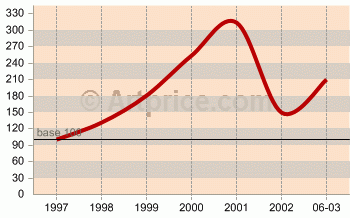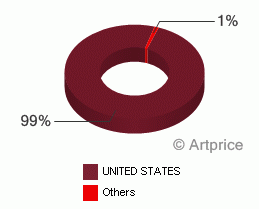Chuck Close (1940)
[06 Jan 2004]
This year the Metropolitan Museum of Art will house a major travelling exhibition of his prints, entitled “Chuck Close Prints: process and collaboration”. The artist’s new record has helped stimulate the uptrend, and print prices are also heading up again.
Chuck Close was born in Monroe in 1940, and studied fine art in Washington, Seattle and Vienna from 1960 to 1965. During this time he became interested in abstract art, inspired by contemporary American avant-garde artists such as Mark Rothko and Jackson Pollock. It was in New York in 1967 that he found his vocation in photorealism. He then produced his first series of very large format portraits including his Big Nude (1967-68), measuring 6.7 metres. His technique at the time was to transfer small Polaroid prints onto enormous canvases using a grid system. He initially worked in black and white before introducing colour in the 1970s. Mirroring printing techniques, he began with only three colours (cyan blue, magenta and yellow). As he worked, he gradually explored new techniques and different media. In 1972 he created his first lithograph, entitled Keith. When he became paralysed in 1988, he refined his work and developed new techniques. This year the Metropolitan Museum of Art will house a major travelling exhibition of his prints, entitled “Chuck Close Prints: process and collaboration”.
Artworks at auctions
Chuck CLOSE ’s highly meticulous approach obviously limits his production. Only one or two paintings at the most come up for auction each year and this scarcity drives up prices. One of his canvasses Cindy II (1988), bought for USD 1.1 million in 1999, went under the hammer for USD 1.3 million on 14 May 2003 at Christie’s New York, representing a new record for the artist, though this could obviously be beaten if a major early canvass were to come onto the market. But such an opportunity has not so far presented itself. As for his drawings, only one came up for auction in 2003, Keith Random Fingerprint (1980), an ink on paper, selling for USD 70,000.
Collectors can find quite a number of photographs at auction but these are less sought after and are often bought in. For example, on 23 September 2003 at Christie’s, the 1972 photograph Study for John only found a buyer at USD 2,400, compared with an estimate of over USD 10,000. Nowadays, Close’s lithographs are a better bet for collectors with less than USD 3,000 to spend, particularly since there is a wide choice (they account for almost two-thirds of lots sold). At auction, lithographs tend to reach and often exceed the most optimistic estimates. Some large-format works can fetch over USD 10,000. For example, print 8/35 of Georgia (1984) a 1.5 metre portrait, went under the hammer at USD 45,000 on 5 May 2001.
The market places
Close’s market is almost exclusively American and all his unique works are sold in New York. That said, it is still possible to find prints in the UK, Sweden and France.
Buy or sell
Boosted by a series of exhibitions including a retrospective at MoMA in 1998, prices soared in 1997-2001 (+214%). The artist’s price index then fell sharply in 2001-2002, as the US market went through a difficult patch, before starting to show signs of recovery in 2003. The artist’s new record has helped stimulate the uptrend, and print prices are also heading up again. For instance, Leslie (1986) a lithograph from an edition of 150 sold for USD 2,700 in 1997, USD 3,000 in 1998, then USD 2,400 in 2002 and finally USD 4,000 in 2003. These excellent results offset the very poor performance recorded in the photography segment.
Chuck CLOSEArtprice Indexall media categories, base January 1997 = 100  Chuck CLOSELots sold at auctions
Chuck CLOSELots sold at auctions  Chuck CLOSEAuction sales turnover 1999-2002 / weight by country
Chuck CLOSEAuction sales turnover 1999-2002 / weight by country  © Artprice
© Artprice




 0
0
